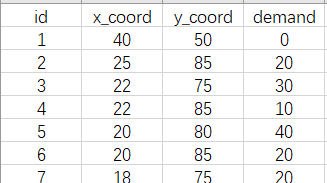Python实现模拟退火算法求解VRP问题
python代码实现
import pandas as pd
import math
import random
import numpy as np
import copy
import xlsxwriter
import matplotlib.pyplot as plt
class Sol():
def __init__(self):
self.nodes_seq=None
self.obj=None
self.routes=None
class Node():
def __init__(self):
self.id=0
self.name=''
self.seq_no=0
self.x_coord=0
self.y_coord=0
self.demand=0
class Model():
def __init__(self):
self.best_sol=None
self.node_list=[]
self.node_seq_no_list=[]
self.depot=None
self.number_of_nodes=0
self.opt_type=0
self.vehicle_cap=0
def readXlsxFile(filepath,model):
node_seq_no = -1
df = pd.read_excel(filepath)
for i in range(df.shape[0]):
node=Node()
node.id=node_seq_no
node.seq_no=node_seq_no
node.x_coord= df['x_coord'][i]
node.y_coord= df['y_coord'][i]
node.demand=df['demand'][i]
if df['demand'][i] == 0:
model.depot=node
else:
model.node_list.append(node)
model.node_seq_no_list.append(node_seq_no)
try:
node.name=df['name'][i]
except:
pass
try:
node.id=df['id'][i]
except:
pass
node_seq_no=node_seq_no+1
model.number_of_nodes=len(model.node_list)
def genInitialSol(node_seq):
node_seq=copy.deepcopy(node_seq)
random.seed(0)
random.shuffle(node_seq)
return node_seq
def createActions(n):
action_list=[]
nswap=n//2
for i in range(nswap):
action_list.append([1, i, i + nswap])
for i in range(0, nswap, 2):
action_list.append([2, i, i + nswap])
for i in range(0, n, 4):
action_list.append([3, i, i + 3])
return action_list
def doACtion(nodes_seq,action):
nodes_seq=copy.deepcopy(nodes_seq)
if action[0]==1:
index_1=action[1]
index_2=action[2]
temporary=nodes_seq[index_1]
nodes_seq[index_1]=nodes_seq[index_2]
nodes_seq[index_2]=temporary
return nodes_seq
elif action[0]==2:
index_1 = action[1]
index_2 = action[2]
temporary=[nodes_seq[index_1],nodes_seq[index_1+1]]
nodes_seq[index_1]=nodes_seq[index_2]
nodes_seq[index_1+1]=nodes_seq[index_2+1]
nodes_seq[index_2]=temporary[0]
nodes_seq[index_2+1]=temporary[1]
return nodes_seq
elif action[0]==3:
index_1=action[1]
index_2=action[2]
nodes_seq[index_1:index_2+1]=list(reversed(nodes_seq[index_1:index_2+1]))
return nodes_seq
def splitRoutes(nodes_seq,model):
num_vehicle = 0
vehicle_routes = []
route = []
remained_cap = model.vehicle_cap
for node_no in nodes_seq:
if remained_cap - model.node_list[node_no].demand >= 0:
route.append(node_no)
remained_cap = remained_cap - model.node_list[node_no].demand
else:
vehicle_routes.append(route)
route = [node_no]
num_vehicle = num_vehicle + 1
remained_cap =model.vehicle_cap - model.node_list[node_no].demand
vehicle_routes.append(route)
return num_vehicle,vehicle_routes
def calDistance(route,model):
distance=0
depot=model.depot
for i in range(len(route)-1):
from_node=model.node_list[route[i]]
to_node=model.node_list[route[i+1]]
distance+=math.sqrt((from_node.x_coord-to_node.x_coord)**2+(from_node.y_coord-to_node.y_coord)**2)
first_node=model.node_list[route[0]]
last_node=model.node_list[route[-1]]
distance+=math.sqrt((depot.x_coord-first_node.x_coord)**2+(depot.y_coord-first_node.y_coord)**2)
distance+=math.sqrt((depot.x_coord-last_node.x_coord)**2+(depot.y_coord - last_node.y_coord)**2)
return distance
def calObj(nodes_seq,model):
num_vehicle, vehicle_routes = splitRoutes(nodes_seq, model)
if model.opt_type==0:
return num_vehicle,vehicle_routes
else:
distance=0
for route in vehicle_routes:
distance+=calDistance(route,model)
return distance,vehicle_routes
def plotObj(obj_list):
plt.rcParams['font.sans-serif'] = ['SimHei']
plt.rcParams['axes.unicode_minus'] = False
plt.plot(np.arange(1,len(obj_list)+1),obj_list)
plt.xlabel('Iterations')
plt.ylabel('Obj Value')
plt.grid()
plt.xlim(1,len(obj_list)+1)
plt.show()
def outPut(model):
work = xlsxwriter.Workbook('result.xlsx')
worksheet = work.add_worksheet()
worksheet.write(0, 0, 'opt_type')
worksheet.write(1, 0, 'obj')
if model.opt_type == 0:
worksheet.write(0, 1, 'number of vehicles')
else:
worksheet.write(0, 1, 'drive distance of vehicles')
worksheet.write(1, 1, model.best_sol.obj)
for row, route in enumerate(model.best_sol.routes):
worksheet.write(row + 2, 0, 'v' + str(row + 1))
r = [str(i) for i in route]
worksheet.write(row + 2, 1, '-'.join(r))
work.close()
def run(filepath,T0,Tf,detaT,v_cap,opt_type):
"""
:param filepath: Xlsx file path
:param T0: Initial temperature
:param Tf: Termination temperature
:param deltaT: Step or proportion of temperature drop
:param v_cap: Vehicle capacity
:param opt_type: Optimization type:0:Minimize the number of vehicles,1:Minimize travel distance
:return:
"""
model=Model()
model.vehicle_cap=v_cap
model.opt_type=opt_type
readXlsxFile(filepath,model)
action_list=createActions(model.number_of_nodes)
history_best_obj=[]
sol=Sol()
sol.nodes_seq=genInitialSol(model.node_seq_no_list)
sol.obj,sol.routes=calObj(sol.nodes_seq,model)
model.best_sol=copy.deepcopy(sol)
history_best_obj.append(sol.obj)
Tk=T0
nTk=len(action_list)
while Tk>=Tf:
for i in range(nTk):
new_sol = Sol()
new_sol.nodes_seq = doACtion(sol.nodes_seq, action_list[i])
new_sol.obj, new_sol.routes = calObj(new_sol.nodes_seq, model)
deta_f=new_sol.obj-sol.obj
if deta_f<0 or math.exp(-deta_f/Tk)>random.random():
sol=copy.deepcopy(new_sol)
if sol.obj<model.best_sol.obj:
model.best_sol=copy.deepcopy(sol)
if detaT<1:
Tk=Tk*detaT
else:
Tk = Tk - detaT
history_best_obj.append(model.best_sol.obj)
print("temperature:%s,local obj:%s best obj: %s" % (Tk,sol.obj,model.best_sol.obj))
plotObj(history_best_obj)
outPut(model)
if __name__=='__main__':
file='../data/cvrp.xlsx'
run(filepath=file,T0=6000,Tf=0.001,detaT=0.9,v_cap=80,opt_type=1)
数据文件


























 249
249











 被折叠的 条评论
为什么被折叠?
被折叠的 条评论
为什么被折叠?








